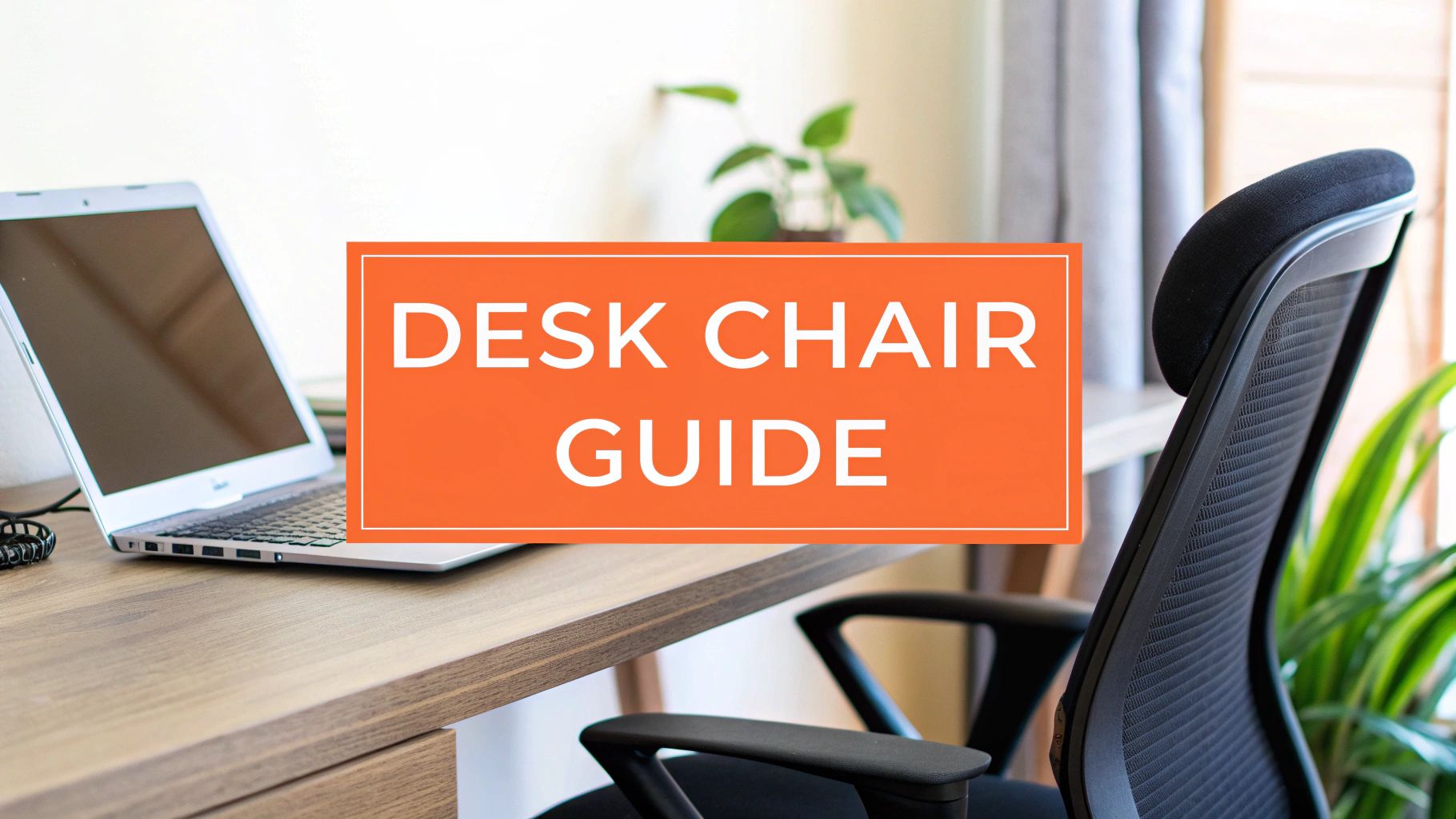That nagging backache after a long day at your desk? It’s a feeling most of us know all too well. But what if your chair was more than just a piece of furniture? What if it was one of your most important tools for feeling good and getting more done? That’s exactly what an ergonomic desk chair is—a chair designed to fit your body, reducing strain and helping you stay focused.
Why Your Chair Is Your Most Important Work Tool
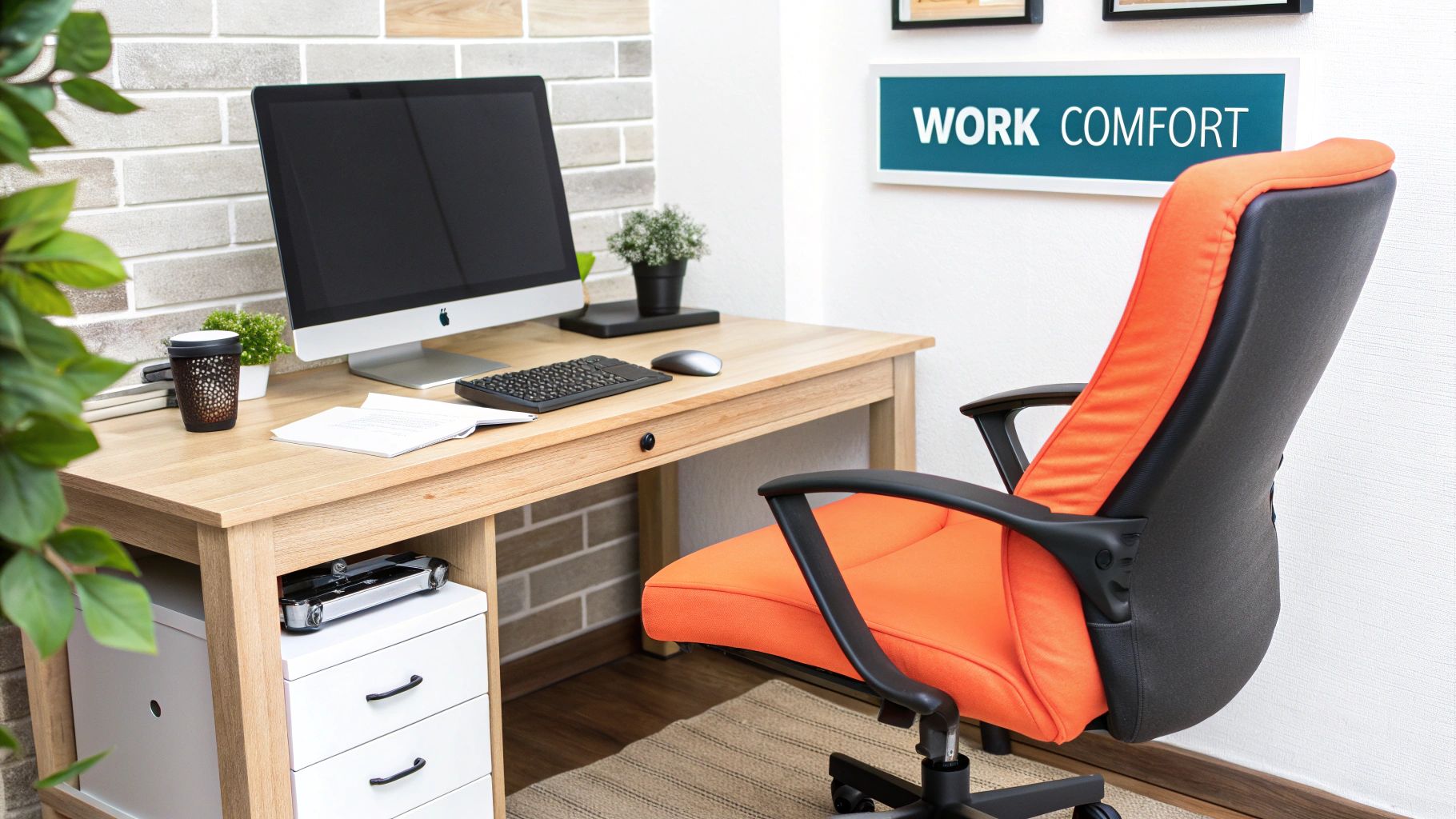
Think about it like this: a professional runner wouldn't use cheap, worn-out shoes. They invest in gear that supports them, prevents injury, and helps them perform at their best. Your chair should be no different. For far too long, we’ve treated the humble office chair as just a place to sit, not the powerful asset for health and productivity it truly is.
The shift to hybrid and remote work across Australia has really brought this issue into focus. When kitchen tables and spare rooms became our full-time offices, many of us discovered that our dining chairs just weren't cut out for an eight-hour day. It’s sparked a huge change in how we think about our work-from-home setups.
The Growing Demand for Better Support
This focus on workplace wellness isn't just a fleeting trend; it's driving real change. In Australia, the office furniture market—which includes ergonomic chairs—was valued at around USD 2.01 billion. It’s expected to grow to USD 3.05 billion by 2034. That's a massive increase, and it's happening because more people are realising that proper support is non-negotiable.
This shift really comes down to a few key realisations:
- Prevention is better than cure. Investing in a supportive chair is about stopping pain before it starts.
- Comfort equals focus. When you're not fidgeting or trying to get comfortable, you can concentrate on your actual work.
- Your workspace matters. A well-designed environment is fundamental to your long-term wellbeing.
An ergonomic chair isn't just about passive comfort. It encourages you to move and change positions, which helps reduce the physical stress that builds up from sitting all day. It’s an active tool for managing your health at work.
This guide will walk you through everything you need to know about choosing and setting up the right ergonomic chair. Of course, a great chair is just one piece of the puzzle. It’s also worth looking into other strategies for protecting your spine in an office environment. By the time you're done, you'll see how the right chair can turn your workday from an endurance test into a comfortable, supported, and productive experience.
Unlocking the Health Benefits of Proper Support
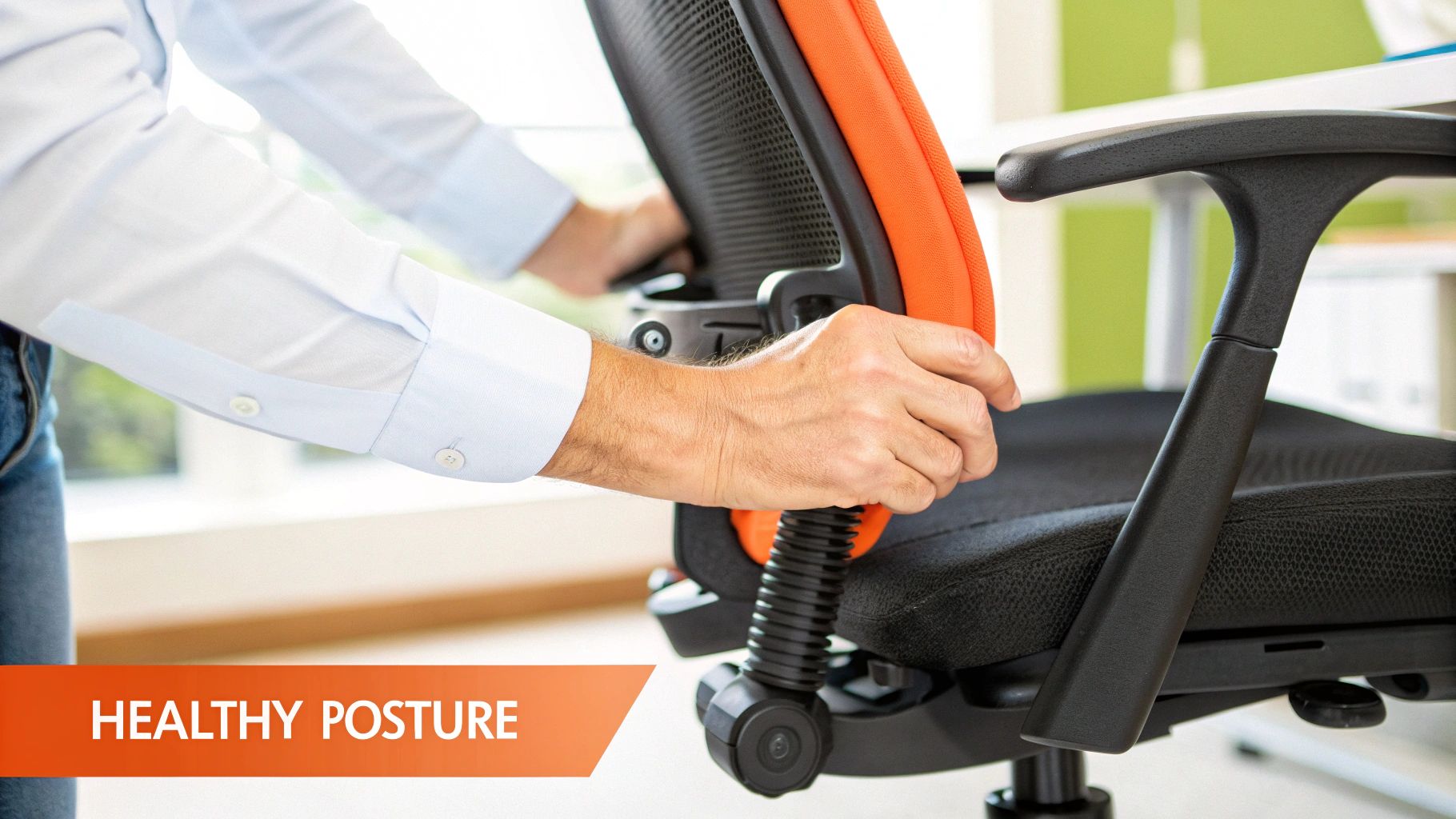
Choosing an ergonomic desk chair is so much more than a simple comfort upgrade; it's a genuine investment in your long-term health and wellbeing. An ill-fitting chair actively works against your body, leading to a whole range of preventable physical issues that can seriously impact your focus and quality of life.
Think of a standard office chair as a one-size-fits-all t-shirt—in reality, it doesn't really fit anyone perfectly. This mismatch is a direct line to musculoskeletal disorders (MSDs), which are those nagging problems affecting your muscles, nerves, and spine.
The fallout from poor seating is more widespread than you might think. Data from Australian workplaces shows that these kinds of conditions are a leading reason for work-related illness claims, making up around 20% of all workers' compensation cases and countless lost work days.
From Chronic Pain to All-Day Comfort
When you understand the "why" behind the benefits, the value of an ergonomic chair really clicks. It's all about cause and effect, where smart design features directly tackle the common sources of pain that build up over a workday.
Combating Lower Back Pain: A typical chair often leaves a gap between your lower back and the chair itself. This forces your lumbar spine to carry the weight of your upper body all on its own. An ergonomic chair with adjustable lumbar support closes that gap, maintaining the natural S-curve of your spine and taking a huge amount of strain off your back.
Preventing Neck and Shoulder Strain: Ever notice yourself hunching forward to reach your keyboard? That often happens when a chair is too low or the armrests are in the wrong spot. Over time, this creates that familiar, persistent tension in your neck and shoulders. The right adjustments help keep your shoulders relaxed and your neck properly aligned.
Alleviating Sciatica and Leg Discomfort: If a seat is too deep or too high, it can press on the back of your thighs, restricting blood flow and even irritating the sciatic nerve. A chair with seat depth adjustment ensures your thighs are supported without creating this harmful pressure point.
These aren't just abstract ideas; they translate directly into a more focused, productive, and pain-free workday. For a closer look at the specific features that make this happen, you might want to read our guide on what makes a chair ergonomic.
A Foundation for Holistic Wellbeing
A great chair is the foundation of a healthy workspace, but it’s still just one piece of the puzzle. While the right chair prevents the big problems, other good habits can help with smaller, related aches. For example, you can take further steps to relieve wrist pain from typing and create a truly comfortable setup.
A truly ergonomic chair adapts to you, not the other way around. It provides dynamic support that moves with your body, encouraging small movements that boost circulation and reduce the static load on your spine.
This adaptability is what really sets ergonomic chairs apart. They don't just give you a place to sit; they offer a personalised support system designed to protect your physical health. By getting rid of the constant, low-level distraction of pain, you free up your mental energy to focus on what matters. An investment in the right chair pays you back every single day, both in performance and in your future health.
Decoding the Features of a Great Ergonomic Chair
Shopping for an ergonomic desk chair can feel like trying to read a different language. You're hit with technical terms like "synchronous tilt," "seat pan sliders," and "4D armrests." It’s easy to get lost in the jargon and lose sight of what really matters: how these features will actually make you more comfortable.
Let's break down these key components. Think of this as your translator, turning confusing specs into practical benefits for your body. We'll go beyond just listing features and explore what they are and, more importantly, why they are so crucial for your daily comfort and long-term health. Getting your head around these elements is the first step toward choosing a chair with confidence.
This image shows you which features are the absolute must-haves for a truly supportive chair.
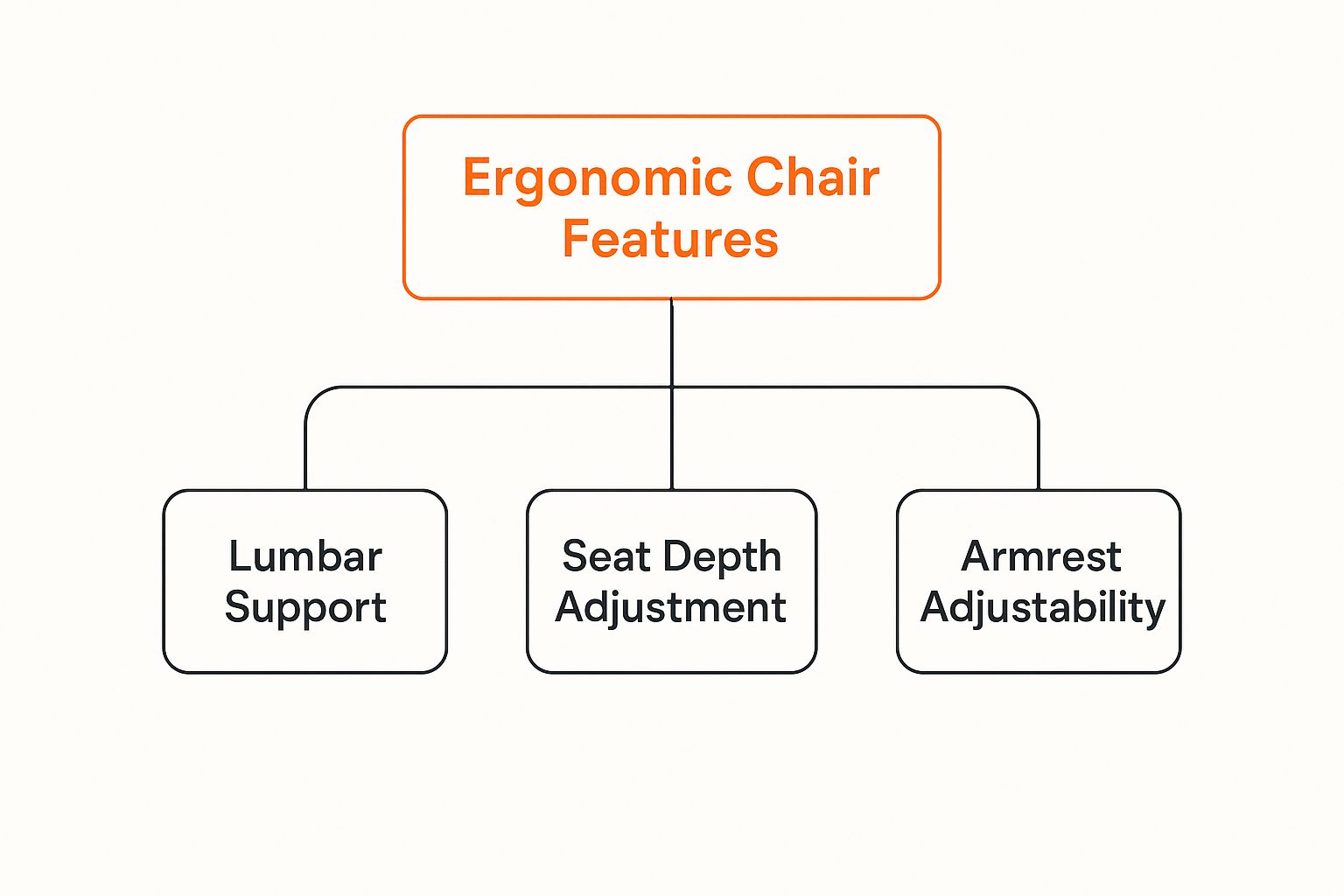
As you can see, things like proper lumbar support, adjustable seat depth, and customisable armrests are the bedrock of a genuinely ergonomic experience.
Getting the Foundation Right: Seat Height and Depth
Let's start with the basics. Seat height might seem simple, but it's the foundation for your entire posture. The goal is to set the chair so your feet are flat on the floor and your knees are at a comfortable, roughly 90-degree angle. This small adjustment is huge for promoting healthy blood circulation in your legs and aligning your body correctly from the ground up.
Next up is seat depth, a less common but critically important feature. Often called a "seat slider," it lets you move the seat pan forwards or backwards, independent of the backrest.
Why does this matter? You want to have a small gap—about two to three fingers' width—between the front edge of the seat and the back of your knees.
- Too deep: The seat edge will press into your calves, cutting off circulation and causing discomfort.
- Too shallow: Your thighs won't be properly supported, leading to instability and strain.
The Heart of Comfort: Back and Lumbar Support
Lumbar support is probably the most famous feature of an ergonomic chair, and for good reason. It’s the curved support in the lower part of the backrest, designed to nestle into the natural inward curve of your lower back (your lumbar spine). The best chairs have adjustable lumbar support, allowing you to fine-tune its height and depth.
Without proper support here, your lower back flattens out, putting a huge amount of strain on your spine. Over an eight-hour day, that's a direct route to fatigue and chronic lower back pain. Good lumbar support maintains your spine’s natural 'S' curve, which is vital for long-term spinal health.
The backrest tilt and tension controls work together to encourage you to move. You can recline the backrest, and a tension knob controls how much effort it takes to lean back.
Slightly reclining to around 100-110 degrees can actually relieve pressure on your spinal discs. By adjusting the tension, you can set the recline so it feels natural—not so stiff that you have to shove, and not so loose that you feel like you're falling. This promotes "dynamic sitting," where you shift positions throughout the day, which is far healthier than staying rigid.
Think of your ergonomic chair's features as a toolkit. Each adjustment is a specific tool you can use to build a seating position that is custom-fit to your body's unique shape and needs.
Fine-Tuning Your Setup: Armrest Adjustability
Armrests are often an afterthought, but getting them right has a massive impact on your neck and shoulder health.
The best armrests are adjustable, letting you move them up and down (height), in and out (width), and sometimes even pivot. The sweet spot is when your shoulders are relaxed and your elbows are bent at a comfortable 90-degree angle.
- If armrests are too high, you’ll end up hunching your shoulders.
- If they're too low, you'll lean to one side to compensate.
Finding that perfect height takes the weight of your arms off your neck and shoulders, which can prevent everything from tension headaches to stubborn knots.
The table below gives you a quick-glance guide to the most important adjustments and what they do for you.
Key Ergonomic Chair Adjustments and Their Purpose
By understanding what each of these adjustments does for your body, you can look past the marketing speak and focus on what truly delivers support. Getting the right mix of these features will make a world of difference to your daily comfort and focus.
To see how these features come together in top-rated models, check out our list of the top 7 best office chairs for posture in 2025.
How to Choose the Right Ergonomic Chair for You
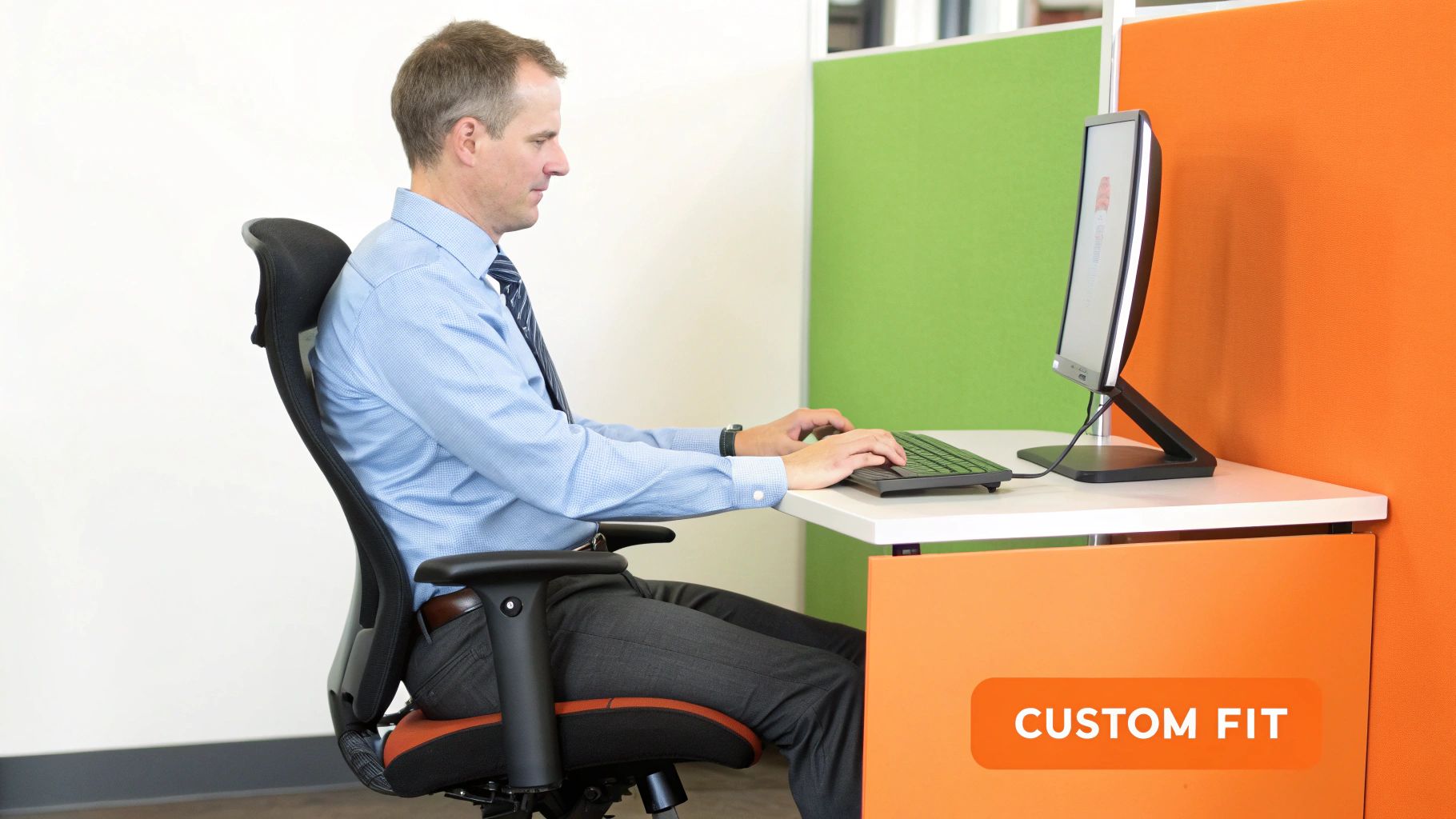
Knowing all the features of an ergonomic chair is a great start, but the real trick is turning that knowledge into the right purchase for you. It’s not just about ticking boxes or having the most levers. The best chair is the one that fits your body, your workday, and even what’s important to you.
Think of it like buying a good pair of running shoes. You wouldn't just grab the first pair off the shelf. You’d think about how you run, your foot shape, and the support you need. Choosing an office chair is exactly the same—it demands a bit of thought.
Let's walk through the essential things to consider. We’ll cover everything from your personal needs to your budget and workspace, giving you a clear checklist to find a chair that feels like it was built just for you.
Start With Yourself: Your Body and Work Habits
Before you even glance at a single chair, the most critical step is to look inward. A chair that’s a dream for a tall person who likes to lean back and think will be a nightmare for someone shorter who sits forward to type all day.
Take a moment to ask yourself a few key questions:
- What’s my height and weight? Many chairs are designed for an ‘average’ frame. If you're taller, shorter, or heavier than that, you’ll want to hunt for models specifically made to support you properly.
- How many hours will I actually be sitting here? Your needs for a full-time, 8-hour workday are worlds apart from someone who just uses their desk for an hour or two. For long stretches, durability and a full suite of adjustments are non-negotiable.
- What kind of work am I doing? Are you constantly hammering away at the keyboard? In back-to-back video calls? Or leaning back to review documents? Your daily tasks dictate which features matter most, like adjustable armrests for typing or a smooth recline for reading.
Answering these questions first gives you a personal "must-have" list. It immediately helps you filter out the options that just won’t work.
Choosing the Right Materials
The material of your chair isn't just about looks; it directly impacts your comfort, its lifespan, and even how warm you feel. The three most common choices you'll find are mesh, fabric, and leather, and each has its own personality.
Mesh ChairsMesh is a fan favourite for one simple reason: breathability. The open weave lets air flow freely, which is a lifesaver if you tend to run warm after sitting for a while. It also flexes and moulds nicely to your body's shape, offering support without feeling rigid.
Fabric ChairsFabric gives you that classic, soft, and cushioned feel. It comes in a massive range of colours and textures, so it’s easy to find one that matches your office style. While it's comfy and generally durable, it’s not as breathable as mesh and can be a bit trickier to clean if you have a spill.
Leather ChairsFor that premium, executive vibe, nothing beats leather. It’s incredibly durable and a breeze to wipe clean. The downside? It’s the least breathable option and can feel a bit warm and sticky in hotter Aussie climates. It also tends to be the priciest of the lot.
When you're deciding, think honestly about your comfort and your workspace. If your home office gets stuffy in the afternoon, the breathability of mesh might be the most important factor for you.
For a deeper dive into these options, our full guide on how to choose an office chair has even more helpful insights.
Considering Sustainability and Your Budget
Your budget is obviously a big piece of the puzzle. But it helps to think of a great ergonomic chair as a long-term investment in your health, not just a purchase. A well-made chair with a solid warranty, like the 15-year warranty on many Pago models, might cost more upfront but saves you from having to buy a replacement in a few years.
On top of that, more and more Australians are looking for sustainable options. There's a growing demand for eco-friendly office furniture, especially chairs made from recycled materials and produced by companies that care about their environmental footprint.
To make a choice you can feel good about, keep an eye out for specific certifications. The Australian market is definitely moving in this direction, with buyers actively seeking products with trusted eco-labels.
Here are the key certifications to look for:
- GECA (Good Environmental Choice Australia): This label is your assurance that a product has met strict environmental, health, and social standards from start to finish.
- FSC (Forest Stewardship Council): This certification guarantees that any wood or paper components come from forests that are managed responsibly.
By choosing a chair with these certifications, you’re not just looking after your own wellbeing—you’re also supporting better manufacturing practices for the planet.
Setting Up Your Chair for Optimal Comfort
Getting a new ergonomic chair is a great first step, but its real magic doesn't happen straight out of the box. You have to tune it to your own body. Think of it less like assembling furniture and more like getting a custom fitting for a suit—it’s the precise adjustments that deliver all the comfort and support.
This setup process isn't complicated, but it is crucial. The aim is to achieve what experts call a 'neutral posture', which is just a fancy way of saying the position where your body is most relaxed and aligned, with the least amount of strain. Taking a few minutes to get this right will make a world of difference.
Your Step-By-Step Setup Guide
Let's walk through the adjustments together. It’s best to follow these steps in order, because each one builds on the last. We’ll start from your feet and work our way up, creating a solid foundation for good posture.
Adjust Your Seat Height FirstThis is always the starting point. Sit down and adjust the height so your feet are flat on the floor. You’re looking for a roughly 90-degree angle at your knees, with your thighs more or less parallel to the ground. This simple tweak is fundamental for good blood flow and aligning the rest of your body.
Set the Seat Depth for Thigh SupportNext, slide the seat pan. Sit all the way back until your lower back makes contact with the backrest. You should be able to fit about two to four fingers between the front edge of the seat and the back of your knees. This ensures your thighs are supported without restricting circulation behind your knees.
Position the Lumbar SupportHere's where you really start to prevent that lower back ache. Adjust the lumbar support up or down so it nestles perfectly into the natural curve of your lower back. It should feel supportive, not like a hard lump pushing you forward. The goal is to gently maintain your spine’s natural "S" curve.
Fine-Tuning for All-Day Comfort
With the main settings dialled in, it’s time for the finishing touches. These might seem like small details, but they’re what eliminate that nagging strain in your neck and shoulders and encourage you to move naturally throughout the day.
A correctly adjusted chair doesn’t just support a single static posture; it supports you through a range of healthy movements. The goal is to create a dynamic sitting environment, not a rigid one.
Now, let's get the backrest and armrests sorted.
Dial in the Backrest Angle and TensionBelieve it or not, sitting bolt upright isn't always best. A slight recline of about 100-110 degrees actually takes more pressure off your spine. Adjust the tilt tension so you can lean back smoothly but still feel supported. You shouldn’t have to shove off with your feet to recline, but you also shouldn’t feel like you’re about to fall backward.
Position Your Armrests CorrectlyFinally, set your armrests so your elbows bend at a comfortable 90-degree angle when your shoulders are relaxed—not hunched up by your ears. Your forearms should rest lightly on them as you type. This takes the strain of your arms off your neck and shoulders, preventing that classic end-of-day tension.
These steps are the foundation of a truly supportive workspace. A great chair is a key piece of the puzzle, but for a complete look at building a comfortable and productive space, check out this guide to an ergonomic home office setup. To take it a step further, our ergonomic workstation setup checklist will help you optimise everything from your monitor to your mouse.
Remember, every body is different. Take the time to play with the settings until it feels just right for you.
Common Questions About Ergonomic Desk Chairs
Even after digging into all the features and benefits, you might still have a few questions. That's completely normal. Choosing the right ergonomic chair is a big decision, and it’s smart to get all your ducks in a row before you commit.
Let's tackle some of the most common things people wonder about. Think of this as clearing up those last-minute doubts so you can feel confident you're making a great choice for your health, comfort, and focus.
Are Expensive Ergonomic Chairs Really Worth It?
It's easy to get sticker shock when you see the price of a high-quality ergonomic chair. But instead of seeing it as a cost, it's better to think of it as a long-term investment in your own wellbeing. You're not just buying a chair; you're buying support.
Cheaper chairs often cut corners where you can't see them. They might use low-density foam that feels fine at first but flattens into a pancake within a year, leaving you with zero support. Their adjustments are usually so basic they can't be dialled in to fit your specific body shape.
A properly engineered ergonomic chair, on the other hand, is built to last. It’s made with durable materials and sophisticated mechanics designed for years of daily work. Most importantly, it's a tool to help you avoid nagging health issues like chronic back pain, which can lead to doctor's bills and days off work. When you spread that cost over its lifespan—often backed by warranties of 10-15 years—and add in the health benefits, the value becomes undeniable.
A premium ergonomic chair isn't just another piece of furniture; it's health equipment. The price reflects the years of design, quality materials, and preventative care it gives your body every single day.
Can an Ergonomic Chair Fix My Existing Back Pain?
This is a really important one. An ergonomic chair can absolutely help relieve the symptoms of existing back pain and is a critical tool for preventing it from getting worse. By encouraging proper posture and taking the load off your spine, it creates the best possible environment for your body to heal.
However, it's not a magic cure. If you're dealing with severe or persistent back pain, your first stop should always be a doctor or a physiotherapist. They can diagnose the root cause and map out a treatment plan—and a good ergonomic chair will almost certainly be a key part of their recommendation. Think of it as a vital supportive tool, not a substitute for professional medical advice.
Ergonomic Chair vs. Task Chair: What's the Difference?
You’ll often hear the terms ‘ergonomic chair’ and ‘task chair’ used interchangeably, but there's a crucial difference between them.
A task chair is really just a general name for any chair designed for use at a desk. It's a very broad category. While many task chairs have a few basic adjustments like seat height, that's often where the customisation stops.
A true ergonomic chair is a highly specialised type of task chair, engineered with the human body in mind. It offers a much deeper and more precise range of adjustments to properly fit all kinds of body shapes and support healthy posture for hours on end.
Here’s a quick breakdown:
The bottom line is that all ergonomic desk chairs are task chairs, but very few task chairs are truly ergonomic. The difference is all in the level of customisation and support you get. To really understand this, learning how to get the most from your chair lumbar support is a great next step.
How Long Should I Sit Before Taking a Break?
Even with the best ergonomic chair on the planet, our bodies simply aren't designed to sit still for eight hours straight. The job of an ergonomic chair is to support you while you’re sitting, not to make it okay to sit forever.
Most ergonomics experts recommend the 30-30 rule: for every 30 minutes of sitting, get up and move for 30 seconds. If that’s not practical, a good goal is to stand up, stretch, and walk around for a few minutes at least once every hour. Set a timer on your phone if it helps you remember!
The best recipe for feeling good at work is a combination of a supportive chair and regular movement. This keeps your muscles engaged, your blood flowing, and your mind clear, boosting both your health and your productivity.
Ready to find a chair that offers uncompromising support and style? At Pago International, we offer a wide range of AFRDI-approved ergonomic desk chairs backed by warranties of up to 15 years. With over two million chairs sold and endless customisation options, you can discover the perfect fit for your body and your home. Explore the Pago collection today.


